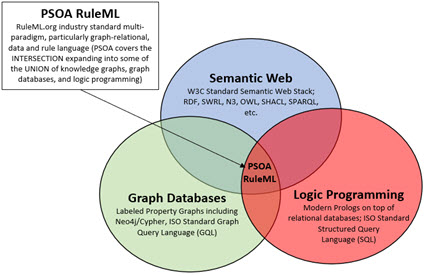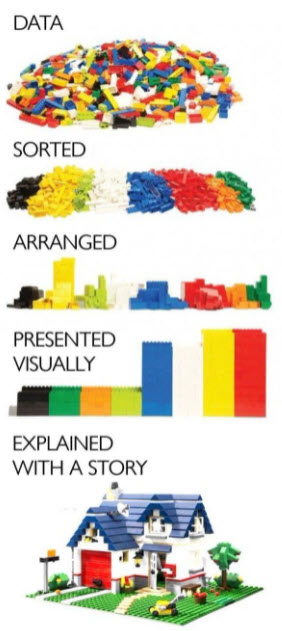In a prior blog post I discussed the three primary problem solving logic paradigms. In that blog post I provided a graphic which I have updated to the following graphic because the RuleML folks have, appropriately, changed a term they are using. Here is the new graphic: (note the change in the title of the blue circle from "Knowledge Graph" to "Semantic Web")
 The reason for the change in the blue circle from "Knowledge Graph" to "Semantic Web" is because all three of the above problem solving logic paradigms are approaches to implementing and processing knowledge graphs.
The reason for the change in the blue circle from "Knowledge Graph" to "Semantic Web" is because all three of the above problem solving logic paradigms are approaches to implementing and processing knowledge graphs.
And so, a knowledge graph can be implemented using any of the three primary problem solving logic paradigms:
- Semantic web: (The Knowledge Graph Cookbook: Recipes that Work explains how to use this approach)
- Graph databases: (Graph Databases explains how to use this approach)
- Logic programming: (The Power of Prolog explains how to use Prolog; Learn Prolog Now! explains how to use Prolog; Expert Systems in Prolog is a book on this topic; Building Expert Systems in Prolog is a free PDF; Pacioli is an implementation of this which uses Prolog; Pesseract is an implementation that mainly uses SQL)
Which is the best approach? I cannot tell you; I don't have the proper background. Here is a comparison of the semantic web approach and the graph database approach. Here is a comparison of PROLOG and graph databases. Either of the three approaches can work, each has a different set of pros and cons.
You could also use other standard approaches or even proprietary approaches to implementing knowledge graphs to store information and then processing the information within those knowledge graphs.
Keep in mind that we are talking about knowledge graphs, not data graphs. This will help you understand the difference between data, information, knowledge, insight, and wisdom:
Another really good graphic is the following which someone posted on LinkedIn:
 The focus here is not on the data; rather the focus is automating the process of gaining insight and wisdom as best as possible. There are many syntaxes that can be used for this. And you need more than data to achieve this objective.
The focus here is not on the data; rather the focus is automating the process of gaining insight and wisdom as best as possible. There are many syntaxes that can be used for this. And you need more than data to achieve this objective.
XBRL is a technical syntax. The XBRL technical syntax can be effectively bidirectionally converted between any of the three primary problem solving logic paradigms.
What matters is that the logic provided within any of those technical syntaxes be sufficient to control the information. This is what my method is all about. Yes, you need some standard physical format to move information from point to point. But you need standard meaning/logic to make sure you are not moving garbage around. Controlling your process is critically important to achieving success. This is science.
If you have any insights or comments, please send them to me.
#############################
Prolog: An Influential Language for Knowledge Management and Ontology Engineering
Knowledge Graphs: Introduction, History, Perspectives
Knowledge Representation and Ontologies (Excellent)
Why Semantic Knowledge Graphs are the Only Way to Build an Enterprise Data Fabric
Enterprise Knowledge Graph Trends 2021
RDF Levels Advantages of Labeled Property Graphs
Fluree (Web 3.0 database)
Knowledge Graph Terms (Kurt Cagle)
Datalog in Practice (Video)
Native vs Non-Native Graph Databases
At Its Core: How Is a Graph Database Different from a Relational One?
PROLOG Programming for Artificial Intelligence
